The Firming Creams & Serums Market is expected to record a valuation of USD 12,305.8 million in 2025 and USD 27,407.4 million in 2035, with an overall increase of USD 15,101.6 million, representing a growth of nearly 123% over the decade. The overall expansion reflects a CAGR of 8.3% and more than a 2X increase in global market size.
During the first five-year period from 2025 to 2030, the market expands from USD 12,305.8 million to USD 18,364.9 million, adding USD 6,059.1 million, which accounts for around 40% of the total decade growth. This phase records steady adoption of anti-aging skincare routines, especially among women aged 35-55, driven by the growing demand for elasticity and lift formulations, retinol creams, and collagen-boosting moisturizers. Peptide serums, known for their firming and wrinkle-smoothing benefits, dominate this phase with a 36.3% market share in 2025, while E-commerce platforms lead sales with a 45.8% contribution, supported by premium brand availability and digital marketing expansion.
The second half of the forecast period, from 2030 to 2035, contributes an additional USD 9,042.5 million, accounting for about 60% of total growth, as the market accelerates from USD 18,364.9 million to USD 27,407.4 million. This surge is driven by innovation in peptide complex formulations, AI-based personalized skincare, and the expansion of clinical-grade firming products into mainstream retail. The share of women aged 55 and above continues to rise, supported by the popularity of dermocosmetic and barrier-support products targeting mature skin. At the same time, Asia-Pacific, led by China (CAGR 8.3%) and India (CAGR 9.3%), emerges as the fastest-growing region due to local brand innovation and consumer preference for visible lifting effects.
By 2035, E-commerce and specialty beauty retail are projected to collectively account for over 90% of distribution, while premium skincare lines offering peptide and collagen-based firming serums gain dominance across global markets.
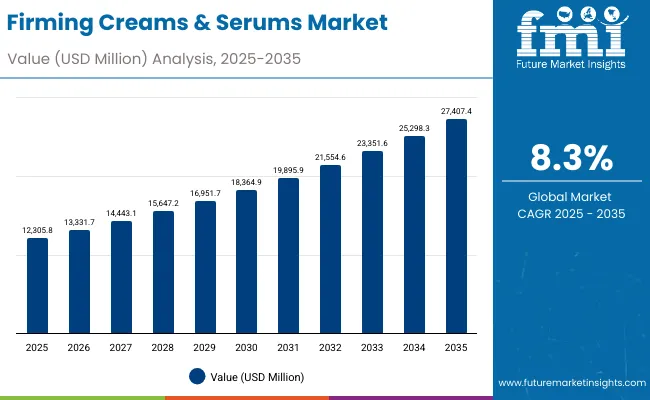
Firming Creams & Serums Market Key Takeaways
| Metric | Value |
|---|---|
| Firming Creams & Serums Market Estimated Value (2025E) | USD 12,305.8 million |
| Firming Creams & Serums Market Forecast Value (2035F) | USD 27,407.4 million |
| Forecast CAGR (2025 to 2035) | 8.3% |
From 2020 to 2024, the Firming Creams & Serums Market expanded steadily, driven by a growing global focus on anti-aging skincare, elasticity restoration, and collagen repair. During this period, retinol creams and peptide-based serums dominated consumer demand, accounting for nearly 60% of the total market share. Major brands such as Estée Lauder, L’Oréal Paris, and Lancôme consolidated their leadership through innovation in peptide complexes, advanced emulsification systems, and dermatologically tested formulations. Competitive differentiation relied on clinical validation, visible results, and skin biome compatibility, while digital marketing and influencer-led campaigns accelerated online conversion rates. Offline specialty retail still represented the bulk of premium sales, though E-commerce rapidly gained traction across key markets.
By 2025, market value is expected to surpass USD 12.3 billion, marking the beginning of a strong decade of premiumization and digital transformation in skincare. Peptide serums are expected to remain the leading segment, supported by new ingredient technologies targeting firmness, elasticity, and wrinkle depth reduction. E-commerce and specialty beauty retail will together command over 90% of sales, reflecting consumer migration toward omnichannel and online-first shopping.
During the forecast period (2025-2035), growth will be driven by innovations in AI-based personalized skincare diagnostics, dermocosmetic-grade firming solutions, and clinical collaborations with dermatologists. Leading brands are evolving from product-centric to ecosystem-based models, combining skincare efficacy with digital consultation tools, subscription skincare plans, and data-driven customization. The competitive advantage is shifting from traditional formulations to scientifically backed, bioactive ingredient blends and sustainably packaged, traceable skincare lines.
The growing consumer demand for anti-aging solutions and visible firming benefits is propelling the Firming Creams & Serums Market. Consumers aged 35 and above are increasingly seeking peptide and collagen-based formulations that enhance elasticity, tone, and lift. The popularity of retinol creams, peptide serums, and neck-firming treatments has surged as skincare routines evolve to target age-related concerns. Brands are responding with clinically validated products that combine dermocosmetic efficacy and luxury appeal, strengthening adoption across both specialty beauty retail and E-commerce channels worldwide.
Technological advances in personalized skincare and ingredient innovation are accelerating market growth. The integration of AI-driven skin analysis tools and bioactive peptide complexes allows brands to offer targeted, customized firming solutions. Premiumization trends, particularly in Asia-Pacific and Europe, are encouraging the use of hybrid formulas combining anti-wrinkle, lifting, and hydration benefits. Moreover, sustainability-conscious consumers favor products with clean labels and recyclable packaging. Together, these factors are creating a strong foundation for innovation-led growth and expanding consumer trust in high-performance firming creams and serums.
The Firming Creams & Serums Market is segmented by product type, function, end user, distribution channel, and region, representing the major factors shaping global growth trends. By product type, the market includes peptide serums, retinol creams, collagen-boosting moisturizers, and neck & jawline firmers, which collectively address elasticity, lifting, and wrinkle reduction concerns across diverse consumer needs. By function, it is divided into elasticity & lift, wrinkle smoothing, barrier support, and neck/décolleté firming, reflecting the targeted performance benefits sought across age groups and skin types. By end user, the market encompasses women aged 35-55, women aged 55+, men, and unisex premium users, with women driving the majority of demand while men’s and unisex formulations expand within the premium skincare segment.
Based on distribution channel, E-commerce, specialty beauty retail, pharmacies/dermocosmetic outlets, and department stores form the primary sales avenues, with E-commerce leading due to rising online engagement and customized skincare recommendations. Regionally, the market spans North America, Europe, East Asia, South Asia & Pacific, Latin America, and the Middle East & Africa, where China (8.3% CAGR) and India (9.3% CAGR) emerge as the fastest-growing markets, while developed regions like the USA, UK, and Germany continue to dominate in premium and clinical skincare categories, reinforcing Asia-Pacific’s leadership in innovation and peptide-based product advancement.
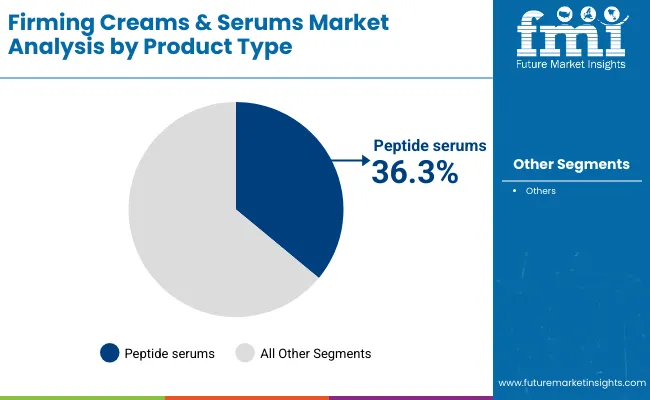
| Product Type | Value Share% 2025 |
|---|---|
| Peptide serums | 36.3% |
| Others | 63.7% |
The peptide serums segment is projected to contribute 36.3% of the Firming Creams & Serums Market revenue in 2025, maintaining its lead as the dominant product category. This growth is driven by the increasing consumer preference for high-performance anti-aging solutions that target skin firmness, elasticity, and collagen synthesis. Peptide-based formulations have gained significant traction due to their ability to promote visible lifting effects, stimulate natural repair mechanisms, and improve overall skin resilience.
The segment’s momentum is further supported by the proliferation of lightweight, fast-absorbing serums suitable for diverse skin types and climates. With continuous innovation in multi-peptide complexes and bioactive ingredient delivery systems, peptide serums are expected to remain the backbone of the firming skincare segment through 2035.
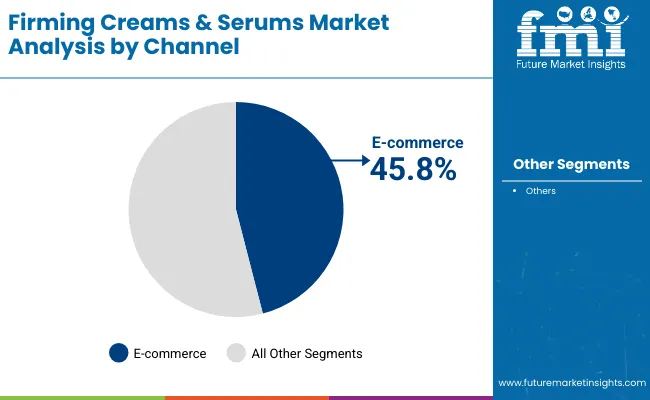
| Channel | Value Share% 2025 |
|---|---|
| E-commerce | 45.8% |
| Others | 54.2% |
The E-commerce channel is forecasted to hold 45.8% of the market share in 2025, emerging as the fastest-growing distribution medium for firming skincare products. This surge is driven by the increasing popularity of online beauty platforms, AI-powered consultations, and personalized product recommendations, which are reshaping how consumers discover and purchase skincare solutions.
E-commerce provides unparalleled convenience and accessibility, allowing consumers to explore peptide serums, retinol creams, and collagen-boosting moisturizers from global and local brands with ease. The segment’s growth is further accelerated by influencer-led marketing, live-streaming campaigns, brand-owned digital storefronts, and subscription-based skincare models that build long-term brand loyalty. As digitalization continues to redefine consumer behavior, online retail is expected to remain the dominant channel for both mass-market and premium firming creams and serums throughout the forecast period.
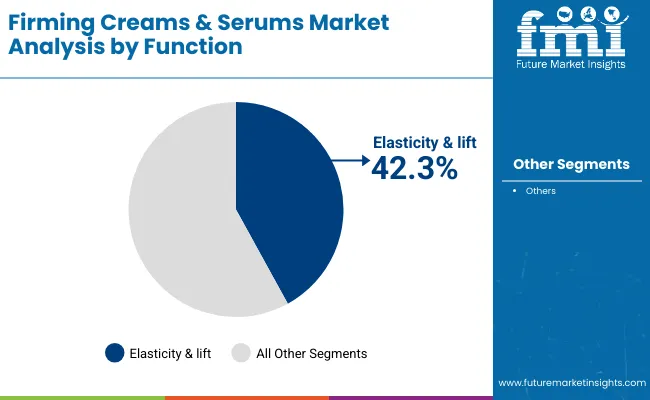
| Function | Value Share% 2025 |
|---|---|
| Elasticity & lift | 42.3% |
| Others | 57.7% |
The elasticity & lift segment is projected to contribute 42.3% of the Firming Creams & Serums Market revenue in 2025, making it the dominant functional category. This growth is primarily fueled by increasing consumer demand for products that enhance skin firmness, redefine facial contours, and restore youthful elasticity. Formulations enriched with multi-peptide complexes, retinol derivatives, and collagen-stimulating ingredients have gained strong consumer acceptance for their clinically validated lifting and tightening effects.
The segment also benefits from ongoing R&D advancements in dermocosmetic technology, including skin biome restoration, micro-lifting mechanisms, and deep-penetration delivery systems. Its widespread appeal among women aged 35-55 the demographic most focused on visible anti-aging results has encouraged brands to expand firming solutions from luxury skincare lines to more affordable, high-efficacy ranges. As a result, the elasticity & lift segment continues to anchor market growth, blending scientific performance with consumer trust and everyday usability.
Rising Demand for Advanced Anti-Aging and Skin-Firming Formulations
The increasing global focus on youthful and healthy skin is driving the Firming Creams & Serums Market. Consumers aged 30 and above are seeking targeted solutions that address elasticity loss, sagging, and fine lines. Formulations containing peptides, retinol, and collagen boosters are gaining popularity for their visible lifting and tightening effects. Brands are investing in clinical testing, dermatological validation, and bioactive ingredient innovation to deliver measurable results. This scientific credibility, coupled with growing skincare awareness and routine adoption, continues to elevate demand across both premium and mass-market segments.
Expansion of Digital Retail and AI-Personalized Skincare Solutions
E-commerce platforms and AI-based diagnostic tools are revolutionizing the skincare purchase experience. Consumers increasingly rely on online consultations, virtual try-ons, and data-driven skincare recommendations to identify firming products tailored to their skin type. Digital-first brands leverage influencer marketing, social commerce, and subscription-based skincare models to enhance engagement and customer retention. The rise of beauty tech integration and AR-assisted skin analysis in online retail channels has made firming creams and serums more accessible, personalized, and results-oriented driving strong revenue growth in both developed and emerging markets.
High Cost of Premium Formulations and Clinical-Grade Validation
The biggest restraint in the Firming Creams & Serums Market lies in the high development and validation costs of advanced formulations. Products featuring bioactive peptides, encapsulated retinol, or plant-derived collagen enhancers require intensive R&D, stability testing, and dermatological trials, all of which raise manufacturing expenses. Moreover, eco-friendly packaging and regulatory compliance add further cost pressure. As a result, premium pricing often limits accessibility for price-sensitive consumers, particularly in developing markets. Bridging the gap between affordability and efficacy remains a key challenge for brands aiming to expand their customer base.
Integration of Biotech-Derived Ingredients and Sustainable Skincare Innovation
A major trend reshaping the Firming Creams & Serums Market is the integration of biotechnology in ingredient development. Brands are adopting bio-fermented peptides, plant stem cell extracts, and microbiome-supporting actives to enhance skin firmness naturally and sustainably. Simultaneously, eco-conscious consumers are pushing companies toward recyclable packaging, refillable containers, and water-efficient formulations. This fusion of biotech innovation and environmental responsibility reflects a new era of "science-meets-sustainability" in skincare. The trend is transforming how consumers perceive efficacy prioritizing both performance and planet-friendly values in their firming skincare choices.
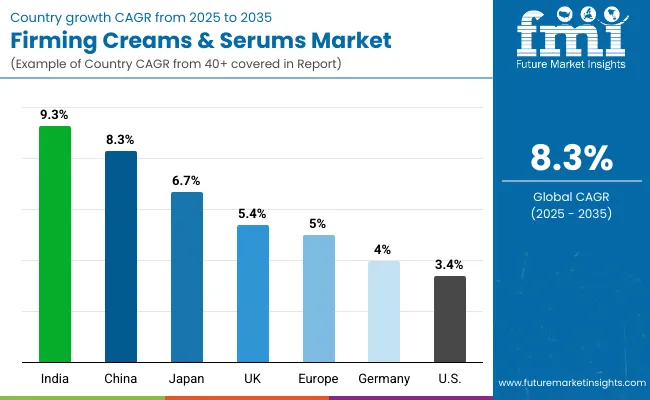
| Countries | Estimated CAGR (2025 to 2035) |
|---|---|
| China | 8.3% |
| USA | 3.4% |
| India | 9.3% |
| UK | 5.4% |
| Germany | 4.0% |
| Japan | 6.7% |
| Europe | 5.0% |
The Firming Creams & Serums Market exhibits clear geographical differentiation in growth patterns, primarily shaped by consumer demographics, retail innovation, brand maturity, and cultural beauty preferences.
Asia-Pacific leads global expansion, driven by India (9.3%) and China (8.3%), where rapid urbanization, increasing skincare awareness, and social media influence are redefining beauty consumption. These countries are witnessing an explosion in anti-aging and elasticity-enhancing skincare demand, supported by both international and emerging domestic brands. The popularity of E-commerce platforms such as Tmall, JD.com, and Nykaa is reshaping purchase behavior, allowing peptide-based and collagen-rich formulations to reach a wider audience across diverse income segments.
In Europe, the UK (5.4%) and Germany (4.0%) maintain a steady trajectory, anchored by premium skincare brands, dermatological research, and strong pharmacy retail networks. European consumers prioritize clean-label ingredients, sustainability, and clinically proven results, encouraging innovation in eco-friendly packaging, microbiome-balancing serums, and dermocosmetic-grade formulations. The presence of legacy brands and new green beauty startups ensures balanced growth in both mature and niche categories.
The USA (3.4%) reflects moderate but stable expansion due to its mature premium skincare ecosystem. Growth is driven by AI-powered personalization, celebrity skincare lines, and clean science formulations that appeal to wellness-conscious consumers. Meanwhile, Japan (6.7%) remains a global innovation hub, influencing formulation aesthetics and texture trends across Asia through its focus on minimalist, high-efficacy serums.
Overall, the Asia-Pacific region dominates global momentum, accounting for the majority of incremental market growth through 2035. The convergence of digital commerce, personalized skincare, and sustainable innovation across all major regions underscores a unified shift toward science-driven, transparent, and inclusive skincare experiences in the global Firming Creams & Serums Market.
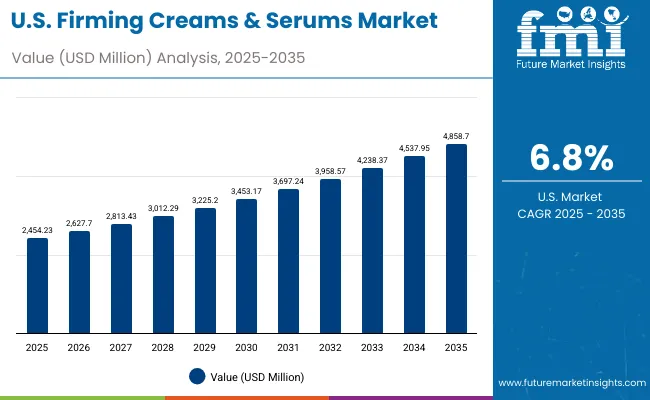
| Year | USA Firming Creams and Serums Market (USD Million) |
|---|---|
| 2025 | 2454.23 |
| 2026 | 2627.70 |
| 2027 | 2813.43 |
| 2028 | 3012.29 |
| 2029 | 3225.20 |
| 2030 | 3453.17 |
| 2031 | 3697.24 |
| 2032 | 3958.57 |
| 2033 | 4238.37 |
| 2034 | 4537.95 |
| 2035 | 4858.70 |
The Firming Creams & Serums Market in the United States is projected to grow at a CAGR of 6.8% from 2025 to 2035, reaching USD 4,858.7 million by 2035. Growth is driven by the strong preference for science-backed, dermatologist-endorsed anti-aging solutions among consumers aged 35 and above. Peptide-based and collagen-enhancing serums dominate sales as consumers seek clinically proven results in firmness and elasticity restoration.
E-commerce and hybrid retail models remain pivotal, supported by platforms such as Sephora, Ulta Beauty, and Amazon, which have expanded their online personalization capabilities using AI and AR-driven consultations. The growing visibility of clean-label formulations and celebrity skincare brands has also fueled premiumization. USA consumers now emphasize clinical efficacy, ingredient transparency, and virtual skincare experiences, marking a transition toward data-driven skincare personalization.
The Firming Creams & Serums Market in the United Kingdom is expected to grow at a CAGR of 5.4% through 2035, propelled by the increasing adoption of dermocosmetic and ethically formulated firming products. Consumers favor clinically tested peptides, retinol complexes, and collagen-boosting actives that deliver visible lifting effects. Established international brands such as Estée Lauder, Clinique, and Lancôme hold a strong presence, while clean-beauty innovators are driving a shift toward sustainable and vegan product lines.
Retail expansion through pharmacy chains, department stores, and online beauty platforms continues to strengthen accessibility, while the integration of AR-based try-on tools and mobile skin analysis applications enhances the digital purchase experience. The UK market is also aligning with eco-certification and carbon-neutral manufacturing initiatives, reinforcing sustainability as a core growth pillar.
India’s Firming Creams & Serums Market is forecast to expand at a CAGR of 9.3%, making it one of the fastest-growing globally. Growth is fueled by rising awareness of skincare science, urbanization, and expanding affordability across tier-2 and tier-3 cities. Younger demographics are increasingly adopting anti-aging and preventive skincare routines, while professional women seek peptide and collagen serums that suit India’s warm and humid climates.
E-commerce platforms such as Nykaa, Amazon, and Purplle have democratized access to premium skincare, enabling mid-tier consumers to explore global and domestic brands. Concurrently, local brands are investing in dermatology partnerships and heat-stable peptide innovations under the Make in India initiative, enhancing regional competitiveness.
China’s Firming Creams & Serums Market is set to grow at a CAGR of 8.3%, the highest among major skincare economies. Demand is driven by luxury skincare adoption, C-beauty innovation, and consumer sophistication in ingredient knowledge. Peptide, niacinamide, and collagen formulations dominate both mass and prestige segments. Local powerhouses such as Pechoin, Proya, and Winona are rapidly expanding, challenging international brands through scientifically backed, affordable product lines.
Digital commerce remains a cornerstone of China’s growth, with Tmall, JD.com, and Douyin reshaping how consumers engage with skincare through live-streaming, influencer marketing, and AI-powered skin assessments. The market’s shift toward dermocosmetic-grade formulations highlights growing trust in clinical efficacy and professional skincare validation.
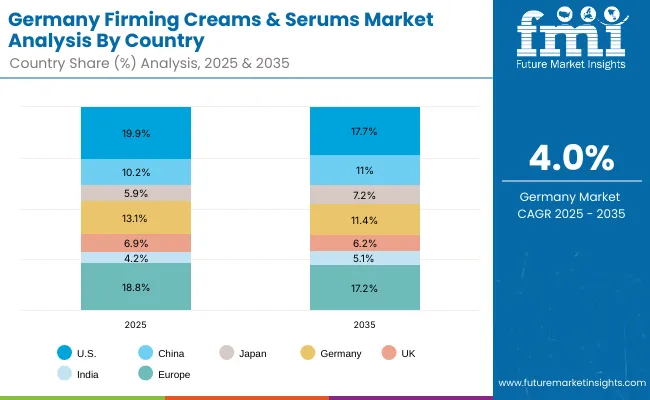
| Country | 2025 Share (%) |
|---|---|
| USA | 19.9% |
| China | 10.2% |
| Japan | 5.9% |
| Germany | 13.1% |
| UK | 6.9% |
| India | 4.2% |
| Europe | 18.8% |
| Country | 2035 Share (%) |
|---|---|
| USA | 17.7% |
| China | 11.0% |
| Japan | 7.2% |
| Germany | 11.4% |
| UK | 6.2% |
| India | 5.1% |
| Europe | 17.2% |
The Firming Creams & Serums Market in Germany is projected to grow at a CAGR of 4.0% between 2025 and 2035, supported by the country’s strong foundation in clinical skincare innovation, dermatological expertise, and sustainability-led cosmetic manufacturing. German consumers exhibit a high preference for medically backed, hypoallergenic, and fragrance-free firming formulations, particularly those featuring peptides, ceramides, and collagen-boosting actives. Brands such as NIVEA, Eucerin, and Dr. Barbara Sturm continue to dominate the domestic landscape through premium product lines designed for mature and sensitive skin types.
The market’s growth is further propelled by the country’s robust pharmacy retail network, where dermocosmetic products account for a significant share of anti-aging skincare sales. In addition, sustainability and ethical sourcing standards mandated by the European Union have encouraged manufacturers to transition toward biodegradable ingredients, recyclable packaging, and carbon-neutral production. German firms are also leading in R&D collaboration with dermatology clinics and universities, fostering innovation in next-generation peptide complexes and microbiome-friendly firming solutions.
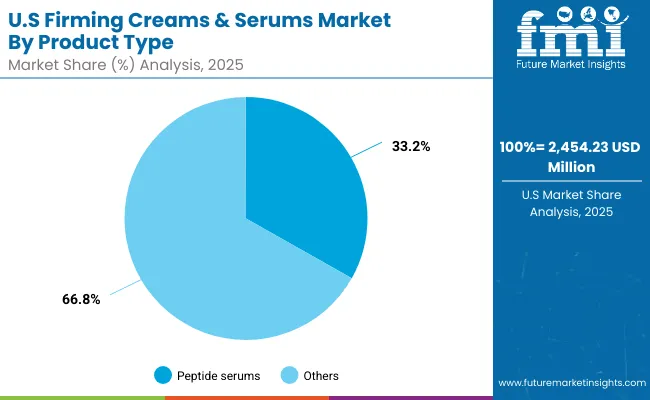
| USA By Product Type | Value Share% 2025 |
|---|---|
| Peptide serums | 33.2% |
| Others | 66.8% |
The Firming Creams & Serums Market in the United States is projected to reach USD 2,454.23 million in 2025, driven by growing consumer demand for scientifically validated, dermatologist-recommended anti-aging solutions. Peptide serums account for 33.2% of total market value, reflecting their leadership in high-performance skincare formulations designed to improve skin elasticity, firmness, and texture. This segment benefits from continuous product innovation featuring multi-peptide complexes, encapsulated retinol, and collagen-boosting actives tailored to mature and photoaged skin.
Growth is further supported by the widespread adoption of digital skincare ecosystems, where AI-based diagnostic tools, personalized product recommendations, and subscription-driven E-commerce models are redefining the consumer journey. Leading brands such as Estée Lauder, Olay, Clinique, and Kiehl’s are leveraging data analytics and AR-driven consultation platforms to enhance personalization and retention rates.
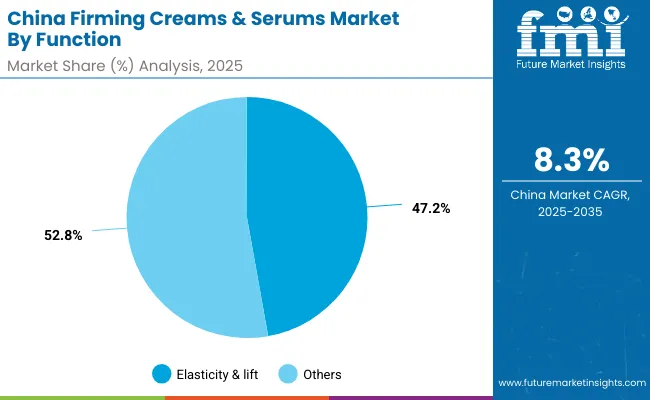
| China By Function | Value Share% 2025 |
|---|---|
| Elasticity & lift | 47.2% |
| Others | 52.8% |
The Firming Creams & Serums Market in China represents one of the most dynamic growth opportunities globally, valued at USD 1,254.38 million in 2025 and forecast to expand at a CAGR of 8.3% through 2035. The elasticity & lift function segment leads with 47.2% share, driven by heightened consumer focus on skin-tightening and contour-defining solutions. This reflects a broader cultural emphasis on youthful appearance and preventive anti-aging skincare, particularly among urban women aged 25-45.
The opportunity landscape in China is being shaped by three major forces:
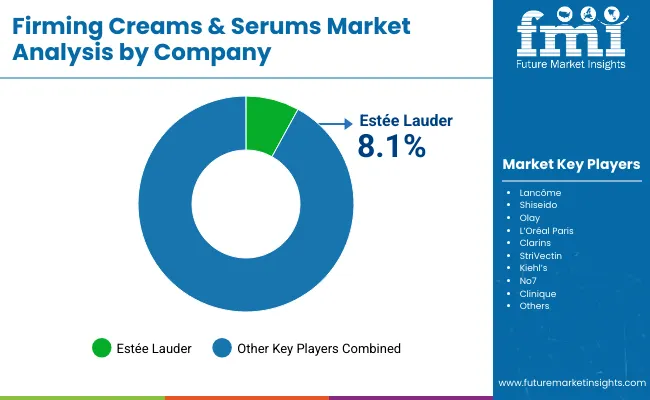
The Firming Creams & Serums Market is moderately fragmented, featuring a blend of global beauty giants, mid-sized innovators, and emerging niche players. Leading global brands such as Estée Lauder, L’Oréal Paris, Lancôme, Shiseido, and Olay collectively account for a significant share, driven by their extensive product portfolios, clinical research investments, and global retail networks. Their strategies emphasize bioactive peptide innovation, AI-based personalized skincare platforms, and sustainable packaging integration to enhance brand loyalty and consumer trust.
Mid-sized and premium niche brands like Clarins, StriVectin, No7, and Kiehl’s are focusing on targeted firming and elasticity-restoring formulations with proven clinical outcomes. These brands differentiate through ingredient transparency, hybrid textures, and dermatologist collaborations, appealing strongly to consumers seeking efficacy and clean beauty standards. Meanwhile, emerging brands in Asia, particularly from China and South Korea, are leveraging peptide-complex formulations, influencer-driven marketing, and affordable pricing to disrupt traditional luxury segments.
The competitive differentiation within this market is rapidly shifting from product claims alone toward ecosystem-based skincare experiences including digital consultations, subscription skincare routines, and data-driven product recommendations. Sustainability, clinical validation, and consumer personalization have become the key battlegrounds shaping future brand positioning.
Key Developments in Firming Creams & Serums Market
| Item | Value |
|---|---|
| Quantitative Units | USD 12,305.8 Million |
| Product Type | Peptide serums, Retinol creams, Collagen-boosting moisturizers, Neck & jawline firmers |
| Function | Elasticity & lift, Wrinkle smoothing, Barrier support, Neck/décolleté firming |
| Channel | E-commerce, Specialty beauty retail, Pharmacies/dermocosmetic, Department stores |
| End User | Women 35-55, Women 55+, Men, Unisex premium users |
| Regions Covered | North America, Europe, Asia-Pacific, Latin America, Middle East & Africa |
| Country Covered | United States, Canada, Germany, France, United Kingdom, China, Japan, India, Brazil, South Africa |
| Key Companies Profiled | Estée Lauder, Lancôme, Shiseido, Olay, L’Oréal Paris, Clarins, StriVectin, Kiehl’s, No7, Clinique |
| Additional Attributes | Dollar sales by product type, function, distribution channel, and end user; adoption trends in anti-aging and dermocosmetic skincare; rising demand for peptide serums, retinol creams, and collagen-boosting moisturizers; segmental growth driven by E-commerce and specialty beauty retail; revenue expansion across women aged 35-55 and 55+ demographics; integration of AI-based skin analysis, AR/VR-powered virtual consultations, and personalized skincare diagnostics; regional trends influenced by premiumization, clinical skincare validation, and clean beauty movements; and innovations in bioactive peptide complexes, encapsulated retinol delivery systems, microbiome-friendly formulations, and sustainable packaging solutions. |
The global Firming Creams & Serums Market is estimated to be valued at USD 12,305.8 million in 2025.
The market size for the Firming Creams & Serums Market is projected to reach USD 27,407.4 million by 2035.
The Firming Creams & Serums Market is expected to grow at a 8.3% CAGR between 2025 and 2035.
The key product types in the Firming Creams & Serums Market are peptide serums, retinol creams, collagen-boosting moisturizers, and neck & jawline firmers. These formulations target skin elasticity, lifting, and wrinkle reduction, forming the core of anti-aging skincare portfolios across global and regional brands.
In terms of distribution reach, the E-commerce segment is expected to command a significant share of 45.8% in the Firming Creams & Serums Market in 2025, driven by growing online beauty retail, digital consultations, and personalized skincare recommendations that enhance product accessibility and consumer engagement.






Our Research Products

The "Full Research Suite" delivers actionable market intel, deep dives on markets or technologies, so clients act faster, cut risk, and unlock growth.

The Leaderboard benchmarks and ranks top vendors, classifying them as Established Leaders, Leading Challengers, or Disruptors & Challengers.

Locates where complements amplify value and substitutes erode it, forecasting net impact by horizon

We deliver granular, decision-grade intel: market sizing, 5-year forecasts, pricing, adoption, usage, revenue, and operational KPIs—plus competitor tracking, regulation, and value chains—across 60 countries broadly.

Spot the shifts before they hit your P&L. We track inflection points, adoption curves, pricing moves, and ecosystem plays to show where demand is heading, why it is changing, and what to do next across high-growth markets and disruptive tech

Real-time reads of user behavior. We track shifting priorities, perceptions of today’s and next-gen services, and provider experience, then pace how fast tech moves from trial to adoption, blending buyer, consumer, and channel inputs with social signals (#WhySwitch, #UX).

Partner with our analyst team to build a custom report designed around your business priorities. From analysing market trends to assessing competitors or crafting bespoke datasets, we tailor insights to your needs.
Supplier Intelligence
Discovery & Profiling
Capacity & Footprint
Performance & Risk
Compliance & Governance
Commercial Readiness
Who Supplies Whom
Scorecards & Shortlists
Playbooks & Docs
Category Intelligence
Definition & Scope
Demand & Use Cases
Cost Drivers
Market Structure
Supply Chain Map
Trade & Policy
Operating Norms
Deliverables
Buyer Intelligence
Account Basics
Spend & Scope
Procurement Model
Vendor Requirements
Terms & Policies
Entry Strategy
Pain Points & Triggers
Outputs
Pricing Analysis
Benchmarks
Trends
Should-Cost
Indexation
Landed Cost
Commercial Terms
Deliverables
Brand Analysis
Positioning & Value Prop
Share & Presence
Customer Evidence
Go-to-Market
Digital & Reputation
Compliance & Trust
KPIs & Gaps
Outputs
Full Research Suite comprises of:
Market outlook & trends analysis
Interviews & case studies
Strategic recommendations
Vendor profiles & capabilities analysis
5-year forecasts
8 regions and 60+ country-level data splits
Market segment data splits
12 months of continuous data updates
DELIVERED AS:
PDF EXCEL ONLINE
Body Firming Creams Market Growth & Forecast 2025-2035
Anti-Aging Creams & Serums Market Size and Share Forecast Outlook 2025 to 2035
Peptide-Enhanced Firming Creams Market Analysis - Size and Share Forecast Outlook 2025 to 2035
Firming Agents Botox-Like Market Size and Share Forecast Outlook 2025 to 2035
Firming Agents Market Growth – Product Innovations & Applications from 2025 to 2035
Hair Serums Ingredient Market Size and Share Forecast Outlook 2025 to 2035
Cryo Serums Market Size and Share Forecast Outlook 2025 to 2035
Slugging Creams Market Size and Share Forecast Outlook 2025 to 2035
Vitamin C Serums (Ascorbic Acid) Market Analysis - Size and Share Forecast Outlook 2025 to 2035
Anti-Aging Serums Market Analysis by Type, Application and Region from 2025 to 2035
Niacinamide Serums Market Size and Share Forecast Outlook 2025 to 2035
Hair Growth Serums Market Analysis - Size and Share Forecast Outlook 2025 to 2035
Anti-Wrinkle Creams Market Size and Share Forecast Outlook 2025 to 2035
Eczema Relief Creams Market Analysis - Size and Share Forecast Outlook 2025 to 2035
Muscle Relaxing Creams Market Size and Share Forecast Outlook 2025 to 2035
Plant-Based Ice Creams Market Analysis by Form, Product Type, Flavor, Source, Sales Channel, and Region through 2035
Caffeine-Infused Serums Market Analysis - Size and Share Forecast Outlook 2025 to 2035
Almond Oil-Based Serums Market Size and Share Forecast Outlook 2025 to 2035
Moisturizing Body Creams Market Size and Share Forecast Outlook 2025 to 2035
Age-Defying Night Creams Market Analysis - Size and Share Forecast Outlook 2025 to 2035

Thank you!
You will receive an email from our Business Development Manager. Please be sure to check your SPAM/JUNK folder too.
Chat With
MaRIA